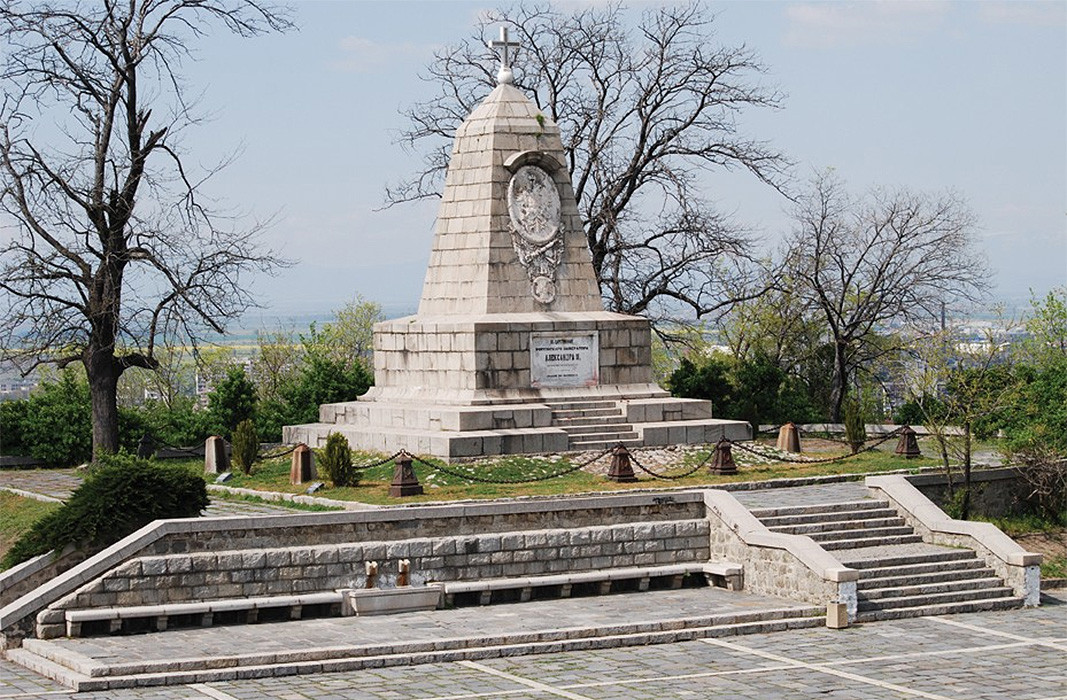After the Liberation of Bulgaria from Ottoman rule, the grateful Bulgarian people erected several hundred monuments to show gratitude for the heroism and self-sacrifice of the thousands of soldiers who gave their lives for freedom.
The first monument

The Monument to Russian Liberators, dedicated to the victory near Plovdiv in January 1878, was erected in the city in September 1881 and is part of 11 “Victory Monuments” erected in Bulgaria according to a project by architect Vokar at the sites of the bloodiest battles during the Russo-Turkish War (1877-1878). The stone monuments have the same pyramidal shapes with a cross at the top and are about 11 meters high, with marble decoration on the fronts, which includes the Russian coat of arms, shield and military armor, St. George's Cross and plaques with inscriptions and names of military formations that participated in the battles.
The most majestic

This is the Monument to the Tsar Liberator in Sofia, situated in front of the National Assembly - an expression of gratitude of the Bulgarians to the Russian people and Emperor Alexander II. An international competition was announced for the erection of the monument back in 1900, in which sculptors from 13 countries took part. The contest was won by Italian Arnoldo Zocchi and the monument was completed in 1903. The 4.5-meter figure of the Russian emperor on horseback, holding the Manifesto of War in his right hand, is made of bronze and is placed on a 7.5 -meter pedestal of black polished granite. The front part of the monument is decorated with a bronze laurel wreath, a gift from the Carol I of Romania in memory of the fallen Romanian soldiers, with the inscription "Tsar Liberator / Grateful Bulgaria". Every year, on March 3, a solemn fireworks display is held in front of the monument, in which the President of the Republic of Bulgaria and military units of the Bulgarian Army take part.
The biggest one

During the War of Liberation for Bulgaria (1876-1878) one of the most decisive battles took place on the peak of Shipka in Stara Planina (the Balkan Range). About 6,000 Bulgarians took part in the battles along with Russian troops. Their feat is immortalized by the Monument of Freedom (known as the Shipka Monument). Its official opening took place in 1934, in the presence of Tsar Boris III. Segments of the monument were transported to the top of the mountain by mule carts and assembled on site. The monument is 31.5 meters high and resembles a tower in the shape of a truncated pyramid. A huge bronze lion is placed at the entrance, while on three sides the names of places of great battles are seen - Shipka, Stara Zagora and Sheynovo. On the ground floor there is a large marble sarcophagus, which keeps the bones of Bulgarian volunteers and Russian soldiers. 894 stairs lead to the monument and thousands of people climb them every March 3rd to honor the memory of those who died for Liberation.
The most beautiful

The Monument of Liberty in the city of Ruse is probably the only monument in Bulgaria in honor of the Liberation, depicting a woman. It was designed in the early twentieth century by Arnoldo Zocchi and is part of the coat of arms of the city. At the top of a pyramidal composition, the statue holds a sword in her left hand and points to the north with her right hand – the direction where the Russian liberation troops came from. At the base of the monument, which is 17.80 meters high, there are three bas-reliefs depicting scenes from the struggle for national liberation, as well as two lions - one breaking the chains of oppression and the other holding a sword and shield, symbolizing freedom. 2 cannons are placed at the back of the monument’s base. The monument was revealed on August 11, 1909 and the ceremony was attended by many veterans of the April Uprising and the Russo-Turkish Liberation War, including Rayna Knyaginya (who embroidered the flag of the Uprising) and voivode Panayot Hitov.
The newest one

This is the monument commemorating Bulgaria’s Liberation, unveiled on August 24, 2008 in the capital city of Sofia. It is a 7-meter-high bronze statue of a volunteer with a flag, standing on a rectangular pedestal. On three of the sides of the monument, engravings dedicated to great moments of the Liberation War can be seen, while on the fourth side one can see a map showing the path of the volunteers (opalchentsi). Next to the monument a stone brought from Shipka is placed. In a special niche under the bas-relief with the map, there are 12 bronze capsules with the names of 12,000 volunteers who took part in the war, an urn with soil from the battlefields, a box with a message to future generations and a list of donors who helped in building the monument.
Author: Desislava Semkovska
English: Alexander Markov
Photos: BGNES, libraryOn October 26, the Bulgarian Orthodox Church marks the Day of Great Martyr St. Demetrius of Thessaloniki, considered one of the greatest saints. In Bulgaria, his name is also associated with the restoration of the Second Bulgarian..
Exactly a year ago, the Bulgarian Orthodox Church established a new holiday in the church calendar - the Glorification of the holy relics of Saint Euthymius, Patriarch of T a rnovo . According to church sources, the last..
They call Nikopol “the town of ages” because its history goes back thousands of years. It was founded as a settlement in the year 169 during the reign of Roman Emperor Marcus Aurelius. In 629, theByzantine Emperor renamed the town to Nicopolis, meaning..
The Patriarchal Cathedral of St Alexander Nevsky is celebrating its temple feast today. The cathedral, a symbol of the Bulgarian capital, was built "in..
On November 24, the Bulgarian Orthodox Church honors St. Catherine (Sveta Ekaterina in Bulgarian) , who was one of the most educated women of her time...

+359 2 9336 661
